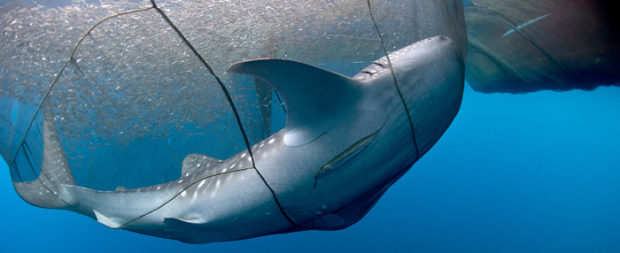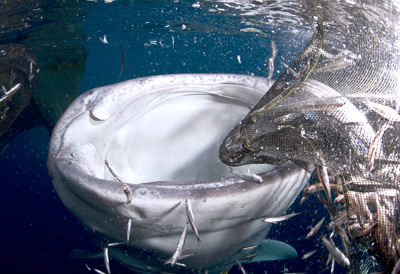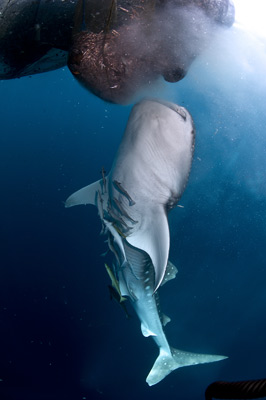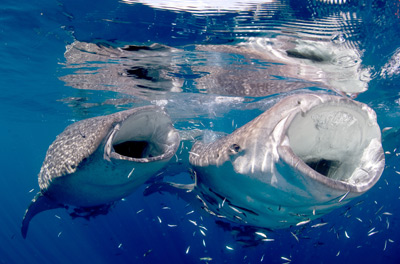The Whale Sharks of Cenderawasih Bay

Text and Photography by Michael AW
I was at the surface composing a shot of three whale sharks as they peered at fishermen in the parallel universe above. Like a pet anticipating a treat, the big fish looked hopeful and their patience deserves a mention too. Focused on these animals I was unaware that two bigger sharks had approached the floating platform from the rear. I felt a gentle but firm push and then I was in their midst, sandwiched between five animals, each weighing about 15 tons!
Now you might think the worst at a time like this but experience has taught me to stay cool and, within the bounds of safety, enjoy the moment. The pet analogy is not too far off. At worst it was a rather undignified moment. Sloppy kind of sums it up. Their enormous fleshy mouths were opened wide all around me. They had one thing on their minds and I knew it wasn’t me. Despite being in the middle of this aquatic scrum, the sharks were gentle, aware of my presence and I am here to relate this story so quite obviously it had a happy ending. Without a bump or bruise I was able to fin away, awed by the interaction and with a grin on my face about as big as the sharks. It’s a ‘whale’ tale I savour and I’m still talking about it.
All this took place around what are called ‘bagans’, or fishing platforms, found in the southern part of Cenderawasih Bay Marine Park, West Papua, Indonesia. The discovery of large congregations of whale sharks (Rhincodon typus) here is recent and what makes it unusual is that both anecdotal and scientific reports suggest their presence is year round and pretty much 24/7.

Evolutionary Cauldron
There are a number of places in the world where these sharks congregate: Christmas Island, the Red Sea, Galápagos, Belize, the Seychelles, Western Australia’s Ningaloo reefs, and Donsol in the Philippines, but at each of these places the sharks are transient. Inside of three months they’re gone; nowhere else in the world that we know of do whale sharks stay put.
Australia’s legendary shark lady, filmmaker and conservationist, Valerie Taylor, calls the phenomenon a natural wonder of our ocean planet.
Located in the Eastern fringe of the Indonesian Archipelago, Cenderawasih Bay is remote and something of a natural wonder itself. Geologists have determined that until recent times, the bay was geologically isolated from the flow of Pacific tides, essentially an ancient sea. This separation over millennia accounts for the high percentage of endemic fish and corals species found there, and nowhere else on the planet. Conservation International ichthyologist, Dr. Gerald Allen, calls the bay “the Galápagos of the East,” based on documented findings in this “evolutionary cauldron” of new and unique corals, shrimps and fish species. Extensive surveys documented 995 species of fish and over 500 of corals, about 10 times greater than in the entire Caribbean.
For us this was icing on the cake. It was our passion for sharks that lured us to this remote outpost. There’s something distinctly adventurous in a journey that begins aboard a Singapore Airlines double decker Airbus 380, then continues on an Express Air 18-seater turbo prop for three days through five airports. All this brought us to Nabire, one of two gateways to Kwatisore, where the whale sharks congregate. To date I’ve made this trek twice, first time out was November of 2010.
The cultural divide was dramatic. From multi-million super airport terminals to a short airstrip surrounded by clothes lines hung with the day’s laundry, dilapidated shacks and a canine welcoming committee as we deplaned. My local assistant, Ronny Rengkung, is a mate of the local police chief of police who made all our arrangements and picked us up at the airport. At dawn the next day our convoy of two small fibreglass boats laden with mounds of camera and dive equipment sped across the calm water of the bay bound for the fishing bagans two half hours north of Nabire.

Big Sucks
It’s in just the past two years that we’ve become aware of whale sharks in Cenderawasih Bay and their fascination with the fishing platforms, rather like a bees and honey relationship. About 23 of these semi-mobile platforms are located in the vicinity of Kwatisore village at the southern end of the marine park. At dusk, massive nets are lowered beneath these platforms to a depth of about 60 feet (18m). Surface floodlights attract millions of Ikan puri, a baitfish about three inches (8cm) in length. In the morning the nets hold tons of the little fish, some of which are used to bait bonitos, but the excess is left in the nets, which hang just beneath the platform. The Whale sharks in the bay have learned to suck the fish out of the netting. Having observed this behaviour, the fishermen then began feeding buckets full of the baitfish to the grateful sharks.
The very first time we approached a bagan the fishermen told us there was a shark below. In a flash, we donned masks and fins and dived in to find a 10-foot (3m) long juvenile. We were feeling greedy so we headed to the next bagan where, we were told, there were many ‘big fish’ to be seen. Sure enough there were seven whale sharks between 10 and 40 feet (3-12m) long swimming around under the platform, occasionally rising up to mouth the bottom of the fish filled nets. They hang vertical in the water as they suck, oblivious of everything around them and moving on only for a breather or if they got bumped off a net by another shark. These were big, powerful animals, and much more gregarious than any other whale sharks I’ve ever encountered. I knew immediately that this location was very special indeed.
Within an hour the sharks outnumbered us. There were about a dozen feeding contentedly from the fish-filled nets. Their eyes are tiny with soft surrounding skin that wrinkles up and closes over the eye as they eat. They were completely at ease in our company, even curious, and would swim past us at mostly avoiding contact though sometimes a gentle push was made to get us out of their feast. Apart from the occasional gentle sideswipe nearly always their enormous tails swished around avoiding the divers. These opportunistic feeders seemed to have our number. We all got along well together throughout the three days of our stay and I hunch their agreeable disposition is innate and not because we weren’t eating the fish.
Little Known About Big Fish
During my second visit to Cenderawasih in September of last year we documented 20 animals beneath five bagans. We were in the water by early morning and seldom finished before dusk. Typical of sharks, lions and even humans, prime feeding times are in the morning and evening before sunset. Typically, we observed two to three juveniles feeding placidly around 7 a.m. but by 10 a.m. the big fish – 10, 6.5 to 40 feet (2-12m) – numbered about 10 and all were eagerly awaiting handouts from the fishermen on the platform. A lull occurs around midday with only a couple of juveniles, not unlike their human counterparts, pushing for more freebies. At about 4 p.m. the beginning of twilight acts as a dinner bell for the sharks. At this time they cast table manners to the currents, toss any semblance of politeness away and frantically rush in with mouths agape, climbing on top of one another to gulp as much food as possible before nightfall.
This was not the best time to connect, however, everyone in our group was able to approach the sharks up close and make eye contact at one time or another. This worked whether we were snorkelling or diving on scuba. At all times they were gentle and it seemed to us that they understood our comparative fraility and behaved accordingly. Some of them actually would rise vertically alongside to pose with us tactile humans, however clumsy and weird a bubble blowing creature we appeared to them. It was during this second trip that I had my up close and personal encounter with the sharks described at the beginning.
Beside the knowledge that whale sharks rise to the surface of the sea to feed on plankton and small fishes, very little is known about the Rhincodon typus. We do know that these largest fish in the ocean are cold-blooded and breathe through gills like other fish. However, their year round congregation and feeding at Cenderawasih Bay is the first observance of this behaviour.

Study is ongoing to better understand the range of these sharks. Last December scientist Mark Erdmann led a Conservation International expedition that successfully tagged five sharks. (see Conservation.org). Currently these whale sharks, the curvaceous Rachel, a large male named Javas and the younger lads, Ren, Stimpy and Cumulus, are out there doing their thing and the tags are storing the daily diving and range data. The tags are pop-up archival satellite-linked tags, which means they stay attached to the animal for a predetermined period, likely about 200 days or six months. At the programmed release date, the tag detaches from the anchored tether and floats to the surface, whereupon its stored data transmits to earth-orbiting satellites in the Argos (Advanced Research and Global Observation Satellite) system. Those data include frequent measurements of depth to document diving patterns, water temperature and their roaming range.
The tagging is a significant effort in a far flung place to learn more about these amazing animals, where and how they mate, how they spend their early years and many other facets of their life cycle unknown to us. The tags will provide some answers. Concurrent with these investigations is the need to protect the animals and their habitat.
Whale sharks are already listed as ‘vulnerable’ by the International Union for Conservation of Nature (IUCN) Redlist. It’s unclear if the whale sharks of Cenderawasih Bay are a local population or not. Regardless, it’s vital to guard them against ruthless shark finning merchants. Whale shark fins command the highest price in Hong Kong. We observed that the sharks get tangled in the fishing nets quite frequently. The fishermen release them but protective measures are needed to ensure the survival of this population.
We didn’t need any convincing that Cenderawasih Bay is a global treasure. With its whale sharks, endemic fishes and fairyland of soft and hard coral reefs, this is an ‘ancient sea’ of distinction. Valarie Taylor is right in her assessment of this wonder of the world. It’s most worthy of our respect and protection. For more information check out www.OGSociety.org
Cenderawasih Bay Marine Park
Location: Southwest quarter of Cendrawasih Bay, Irian Jaya
Coordinates: 01°43′-03°22′ S and 134°06′-135°10 E
Status: National Park
Established: September 2, 1993 (Decree of Ministry of Forestry of Republic of Indonesia No. 472/Kpts-II/1993)
Size (km2): 1,453.5
IUCN Category: II
Features:
The park comprises the southwest quarter of Cenderawasih Bay which lies to the east of the isthmus connecting the Vogelkop Peninsula to the mainland. The park falls within the administrative districts of Manokwari and Nabire. Access is by sea from the towns of Manokwari and Nabire, which lie 95 km and 38 km north and east, respectively. Air transport is available from Manokwari, Biak and Nabire.
For More information:
Nabire Office
15, Jalan RE Martadinata, Nabire 98817 Irian Jaya Indonesia
Tel/Fax. (+62-967) 21289
Email: wwfnabire@jayapura.wasantara.net.id
One Response to “The Whale Sharks of Cenderawasih Bay”
Leave a Comment








David Marsh
I’ld love to see the whalesharks in Cenderawasih Bay. There seems to be some difference of opinion abot the best season. Though the sharks are present “nearly” all year round, some sources say that visibility is best from May to October. I note that the scientific expedition you mention was there in December.
Personally, I would prefer to travel in december. I also want to snorkel and dive in Raja Ampat and apparently seas are calmest there in December. I’ld appreciate your views on visibility seasonally and any information on travel details and accommodation options.
Thanks.